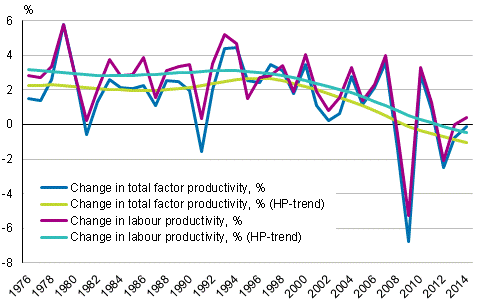Published: 12 May 2016
Development of productivity in the national economy 1976 to 2014
Based on preliminary national accounts data, the growth rate of labour productivity in the whole national economy was 0.4 per cent in 2014. In 2013, labour productivity did not grow and in 2012 it contracted by 2.1 per cent. The respective growth rate of total productivity in the whole national economy was -0.1 per cent in 2014, having been -0.7 per cent in 2013 and -2.5 per cent in 2012.
Development of productivity in the whole national economy 1976 to 2014, %

The Hodrick-Prescott filtered long-term growth trend (HP) indicates that the pace of growth in labour productivity in the whole economy has slowed down strongly since the mid-1990s from 3 to 3.5 per cent to -0.4 per cent in 2014 (Figure 1). Although the annual growth rates for individual years (2000, 2004, 2007 and 2010) have been around three to four per cent, the trend in labour productivity has been declining continuously since the mid-1990s.
The respective long-term growth trend for total factor productivity shows that the average annual growth of total factor productivity was around 2.1 per cent before 1993. Between 1993 and 2000, total factor productivity grew at the average rate of 2.5 per cent per annum. After 2000, the growth trend of total factor productivity has made a clear downturn.
Table 1 shows average annual growths of total factor productivity and labour productivity in different time periods. In addition, the table shows capital input, hours worked and labour composition contributions to value added growth, as well as capital intensity change and labour composition change contributions to labour productivity growth.
The contribution of labour composition to value added growth was strongest during the 1990s (on average, 0.6 percentage points per year). In the other periods, the contribution of labour composition has grown the volume of value added by around 0.2 to 0.3 percentage points per year, on average. The contribution of capital input to value added growth has been fairly stable at an average of 0.9 percentage points per year. Growth has been lower only during the periods 1990 to 1994 and 2009 to 2013, about 0.2 and 0.3 percentage points per year.
Average growths of productivity in the whole national economy, 1976 to 2014
| 1976-1989 | 1990-1994 | 1995-1999 | 2000-2004 | 2005-2008 | 2009-2013 | 2014 1) | |
| Value added volume, change, % | 3.4 | -0.7 | 4.7 | 3.0 | 3.2 | -1.6 | -0.4 |
| Capital input contribution, change, % | 0.9 | 0.2 | 0.6 | 0.9 | 0.8 | 0.3 | 0.2 |
| Worked hours contribution, change, % | 0.3 | -3.1 | 1.4 | 0.4 | 1.0 | -0.7 | -0.5 |
| Labour composition contribution, change, % | 0.3 | 0.7 | 0.6 | 0.2 | 0.1 | 0.2 | 0.0 |
| Multi-factor productivity, change, % | 2.2 | 2.2 | 2.7 | 1.6 | 1.4 | -1.3 | -0.1 |
| Capital intensity contribution, change, % | 0.8 | 1.2 | -0.2 | 0.7 | 0.4 | 0.7 | 0.5 |
| Labour composition contribution, change, % | 0.3 | 0.7 | 0.6 | 0.2 | 0.1 | 0.2 | 0.0 |
| Labour productivity, change, % | 2.9 | 3.4 | 2.5 | 2.3 | 1.8 | -0.6 | 0.4 |
The productivity indicators presented in these statistics are based on the KLEMS method and on the same raw data as EUKLEMS. Further information can be found in the methodological description of the statistics.
Source: Productivity surveys 2014, Statistics Finland.
Inquiries: Ville Tolkki 029 551 2529, kansantalous@stat.fi
Director in charge: Ville Vertanen
Publication in pdf-format (171.7 kB)
- Tables
-
Tables in databases
Pick the data you need into tables, view the data as graphs, or download the data for your use.
Updated 12.5.2016
Statistics:
Productivity surveys [e-publication].
ISSN=2343-4333. 2014. Helsinki: Statistics Finland [referred: 19.4.2024].
Access method: http://www.stat.fi/til/ttut/2014/ttut_2014_2016-05-12_tie_001_en.html

